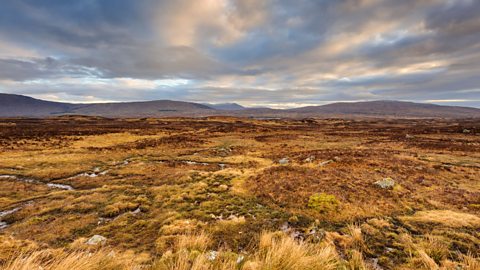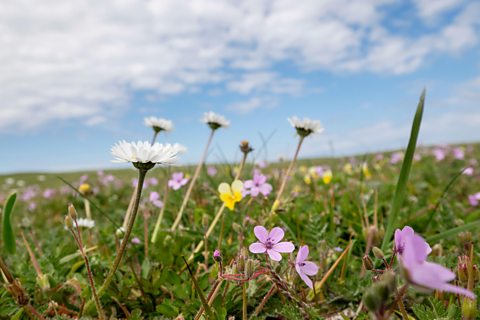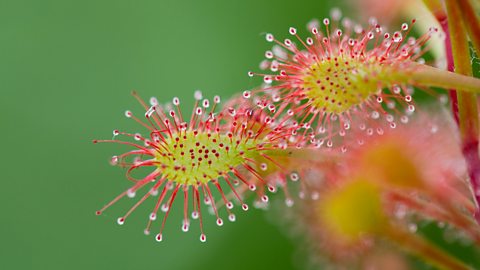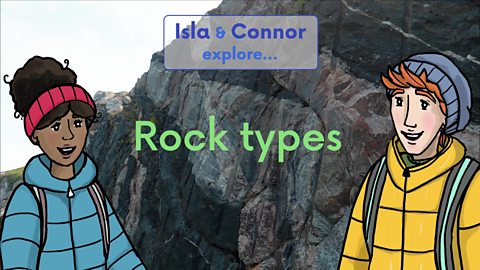What are moorland and machair?
There are hundreds of islands in Scotland and they are home to some unique landscape features, like moorland and machair.
In this article you can learn about:
- What moorlands are
- What peat is and its uses
- What machair is and where it can be found
- Carnivorous plants of Scottish moorland
This resource is suitable for Landscapes topics for primary school learners.
Video - Moorland and machair
Join Isla and Connor as they explore moorland and machair in North Uist.
Watch this short video to find out about moorlands and machair.
ISLA: Woohoo! I love this!
Cycling the Hebridean Way is so much fun.
CONNOR: Yeah, nothing beats this. There are lots of other cycle routes in Scotland we could travel by, too.
What’s this stacked up outside some of the houses?
ISLA: That’s a peat stack. It’s special earth cut from the moorland here. Maybe we’ll see more on our journey.
The peat that makes up this moorland burns really well, so for a long time people have cut it, dried it, collected it and used it to heat their homes, but, it isn’t done as much any more.
The peat bogs are a really special habitat. The moorland looks like it's empty and barren, but it’s actually full of life.
The soil doesn’t let water drain away easily, so it stays wet. Plants like sphagnum moss and others have adapted so that they can grow in these difficult wet conditions.
When they die, they break down and form a layer of peat in the water. The peat holds even more water, so the cycle continues.
CONNOR: So these moorland plants are pretty special then. I’ve heard of sphagnum moss. It can hold eight times its own weight in water, and was used as a wound dressing in World War One because it helps to stop infection.
ISLA: That's some special moss! And because peat - and the moss - are so good at holding water, it helps reduce flooding. It’s good for sheep grazing too.
Besides the moss, peat also grows this beautiful purple heather and these crazy carnivorous plants - the butterwort and…
CONNOR: Sundew! Oh yes. The peat doesn’t have all the nutrients plants need to grow in it, so carnivorous plants have to get extra nutrition from somewhere else…insects! I love a carnivorous plant, who doesn’t?
ISLA: I guess they’re pretty fascinating - in a gruesome kind of way!
CONNOR: Aren’t they! Sundews are covered in stalks that look like tentacles. These produce sweet nectar that attracts insects, and sticky mucus that traps any insects that land on them, and then digests them. When these plants die, the insects also break down in the soil, adding to the otherwise poor mineral nutrition.
ISLA: Haha, I’m not sure I loved that so much Connor, sounds a bit gross to me!
Oh wow, machair! This is so beautiful! The word 'machair' means low lying fertile grassy plain in Gaelic. Look at all the flowers!
It’s because we’re on the edge of the Atlantic here. The strong winds blow calcium rich sands made of crushed shells on shore.
The flowers grow really well here and create these stunning, colourful blooms. They actually change colour as the season goes on and different flowers come into bloom.
CONNOR: I bet it’s great for insects and birds.
ISLA: Like this great yellow bumblebee! They’re so rare, just like the machair itself.
CONNOR: These islands are really special. No wonder so many people visit. There’s a cafe up here - last one there has to buy the ice creams!
How many islands are there in Scotland?
An island is a piece of land surrounded by water. Continents are also surrounded by water but they are too big to be classified as islands.
There are around 800 islands in Scotland and they are home to some unique landscape features.
What is moorland?
- Moorland is a type of landscape or habitat Where an animal or plant lives. made up of bogA very wet muddy area of land. Sometimes called a swamp., and different kinds of grasses and shrubs, like heather.
- Moorland is most often found in upland areas in the north and west of the UK, like the Scottish Highlands and Islands.
- Trees don't grow on moorland because the peaty soil is waterlogged and doesn't have enough nutrients for trees to grow.

What is a peat bog?

- Peat is a special layer of soil made up of organic matterThe waste that comes from living plants and animals that is beginning to breakdown and decay..
- Peat traps carbon dioxide. It is a carbon sinkSomething that can store carbon for a period of time. For example, the ocean or rainforests. Carbon sinks lower the amount of carbon dioxide, a greenhouse gas. .
- It has been used as a traditional source of fuel in some parts of Scotland. Soft peat is cut into slices and laid out to dry. The dried peat is then collected into stacks outside people's homes.
- Like other non-renewableNatural resources that cannot be replaced after they are used. This means that they exist in a fixed amount on Earth. Fossil fuels such as coal, oil and gas are all non-renewable resources. energy sources, burning peat on a large scale isn't good for the environment. This is because burning peat releases carbon dioxide into the air.
- However, in the islands, peat is generally burned on a small scale to fuel individual homes. There are fewer energy alternatives available in some island communities, and energy is often more expensive.
- Peat is also used as compost Waste from plants and animals that has broken down and can be used as a fertilizer for growing plants but this is to be ended in Scotland in the near future.

What is machair?

- Machair is a rare type of habitat Where an animal or plant lives. that is only found in the west of Scotland and Ireland.
- It is formed when wind blows calcium-rich sands onto the shore.
- The word machair means 'low lying fertile grassy plain' in Gaelic.
- In summer machair is covered in colourful flowers.

Map of machair in Scotland
Carnivorous plants
- In the video at the top of the page, Isla and Connor spotted a carnivorous plant called sundew that grows in moorlandAn upland landscape or habitat made up of different kinds of grasses, shrubs and bogs. areas.
- Carnivorous plants usually grow in soil that does not have a lot of nutrientsThe building blocks needed to keep a plant or animal alive and healthy. Animals get most of their nutrients from food. Plants get nutrients from soil and sunlight., like peat.
- They can't get all their nutrients from the soil so they trap and digestTo break down food so that its nutrients and energy can be absorbed. insects.

Image caption, Sundew
Sundew is a carnivorous plant that uses sticky hairs on its leaves to trap insects. They grow in wet heaths and peaty moors, such as Tailend Moss near Bathgate or Glen Moss near Kilmalcolm. (David Chapman / Alamy Stock Photo)
Image caption, Butterwort
Common butterwort uses its sticky leaves to trap insects. It is common in Scotland and Wales where it grows in bogs and heaths. (Peter Martin Rhind / Alamy Stock Photo)
Image caption, Bladderwort
Bladderwort is an aquatic plant which means it grows in water, like ponds, rivers and lochs. It traps small organisms with little sacs on its stems. When the sacs open, they draw in water and organisms like a vacuum. (blickwinkel / Alamy Stock Photo)
Image caption, Pitcher plant
Pitcher plants catch insects with their tubular leaves, which act like a pitfall. Pitcher plants don't grow naturally in Scotland. They can be found in sunny wetlands in North America. (Andrea Obzerova / Alamy Stock Photo)
Image caption, Venus flytrap
Venus fly traps are part of the sundew family. They catch insects using their mouth-like leaves. They are native to wetlands on the east coast of the United States of America, such as North and South Carolina. (Ricky Deacon / Alamy Stock Photo)
1 of 5
Learn about photosynthesis and respiration, and how plants gain nutrients to grow: How do plants get energy and food to grow?

Key words about island landscape features
- moorland - An upland landscape or habitat Where an animal or plant lives. made up of different kinds of grasses, shrubs and bogs.
- bog - A very wet muddy area of land where many types of moss tend to grow. Bogs are acidic and often have very low levels of nutrientsThe building blocks needed to keep a plant or animal alive and healthy. Animals get most of their nutrients from food. Plants get nutrients from soil and sunlight..
- peat - A layer of soil made up of dead plants. It traps carbon dioxide and helps prevent flooding. It has been used a source of fuel in some parts of Scotland.
- carnivorous plant - A plant that can trap and digestTo break down food so that its nutrients and energy can be absorbed. small animals, like insects.
- machair - A rare type of habitat Where an animal or plant lives. covered in colourful flowers found in certain parts of Ireland and Scotland.
Test your knowledge
Quiz
Challenge

Draw and label a picture of a carnivorous plant.
Research a carnivorous plant. Draw a picture of the plant and label some of its key features.
Here are some ideas to get you started:
- What plant are you going to draw? Some examples of carnivorous plants are the pitcher plant and the venus fly trap.
- How does the plant trap insects? Do insects stick to it? Can it trap the insect with a mouth-like part?
- Remember, your plant need roots (to get water from the soil) and leaves (to absorb sunlight through photosynthesisA chemical reaction that takes place in plants. Plants turn carbon dioxide and water into glucose, their main source of energy, and oxygen. Sunlight provides the energy needed for photosynthesis to take place.).
More to learn about islands in Scotland
Why we love living on Great Cumbrae Island. videoWhy we love living on Great Cumbrae Island
The P6/7 pupils from Cumbrae Primary School tell us why they love living on the Island.

More on Landscapes
Find out more by working through a topic
- count20 of 25

- count21 of 25

- count22 of 25

- count23 of 25
